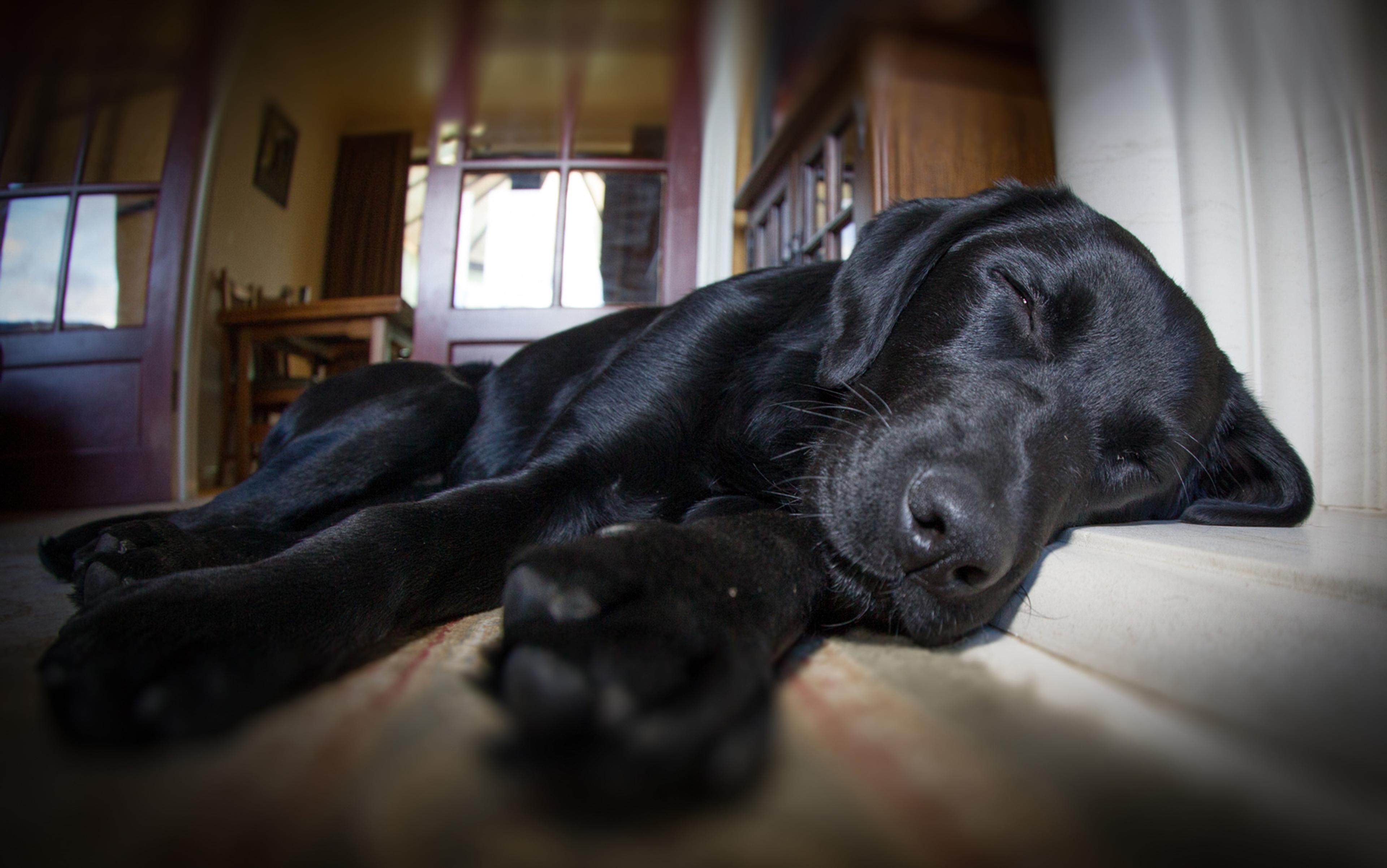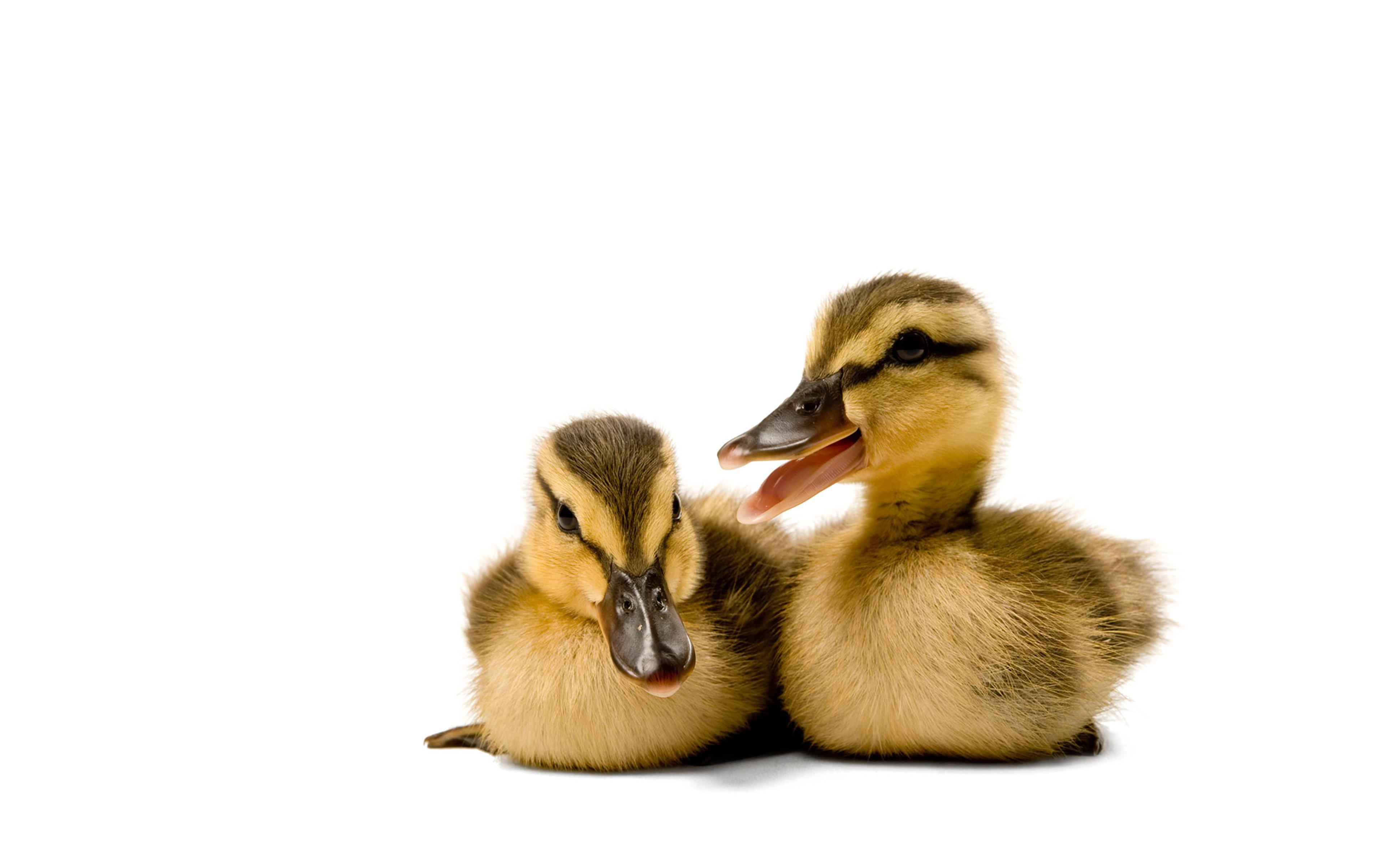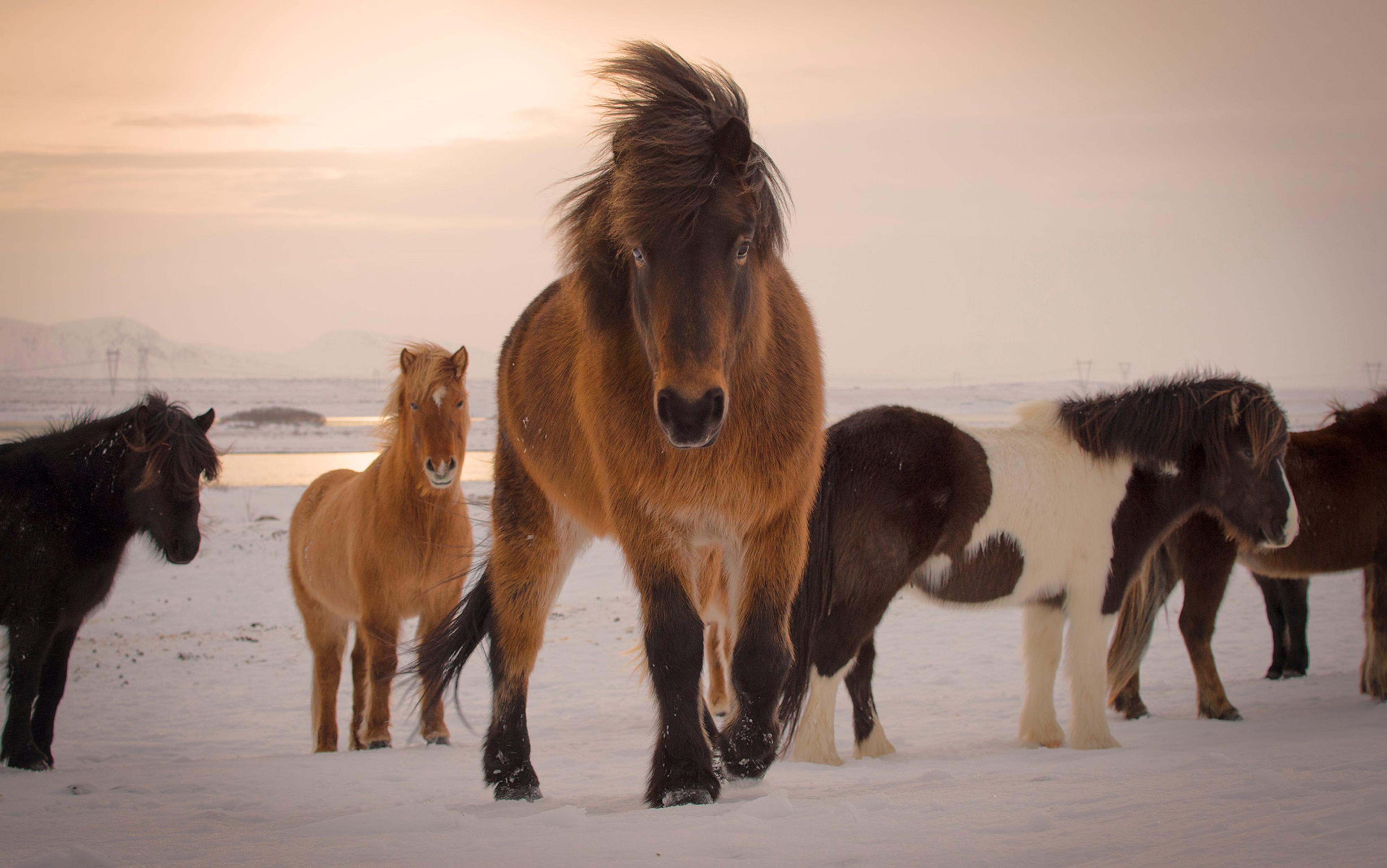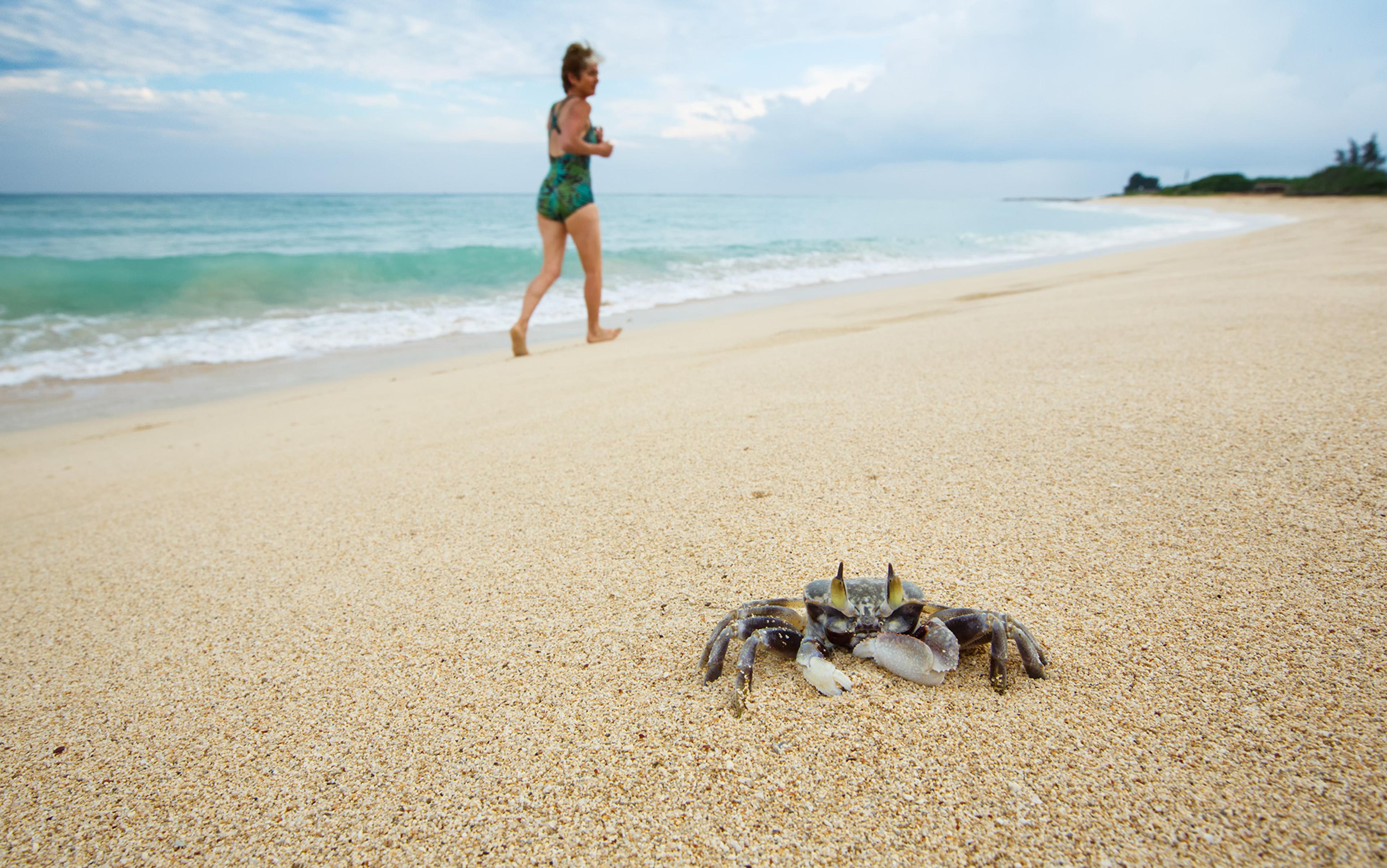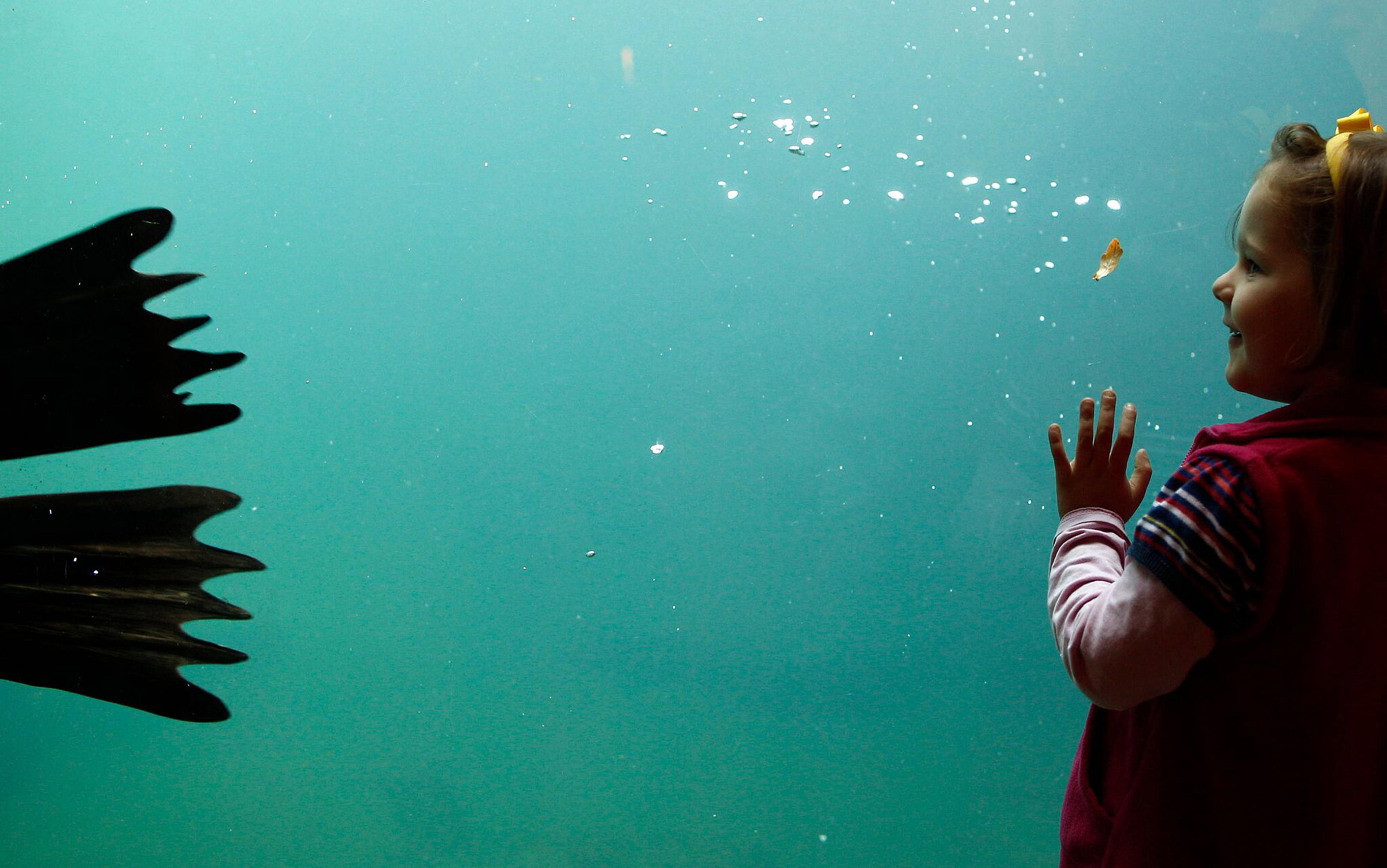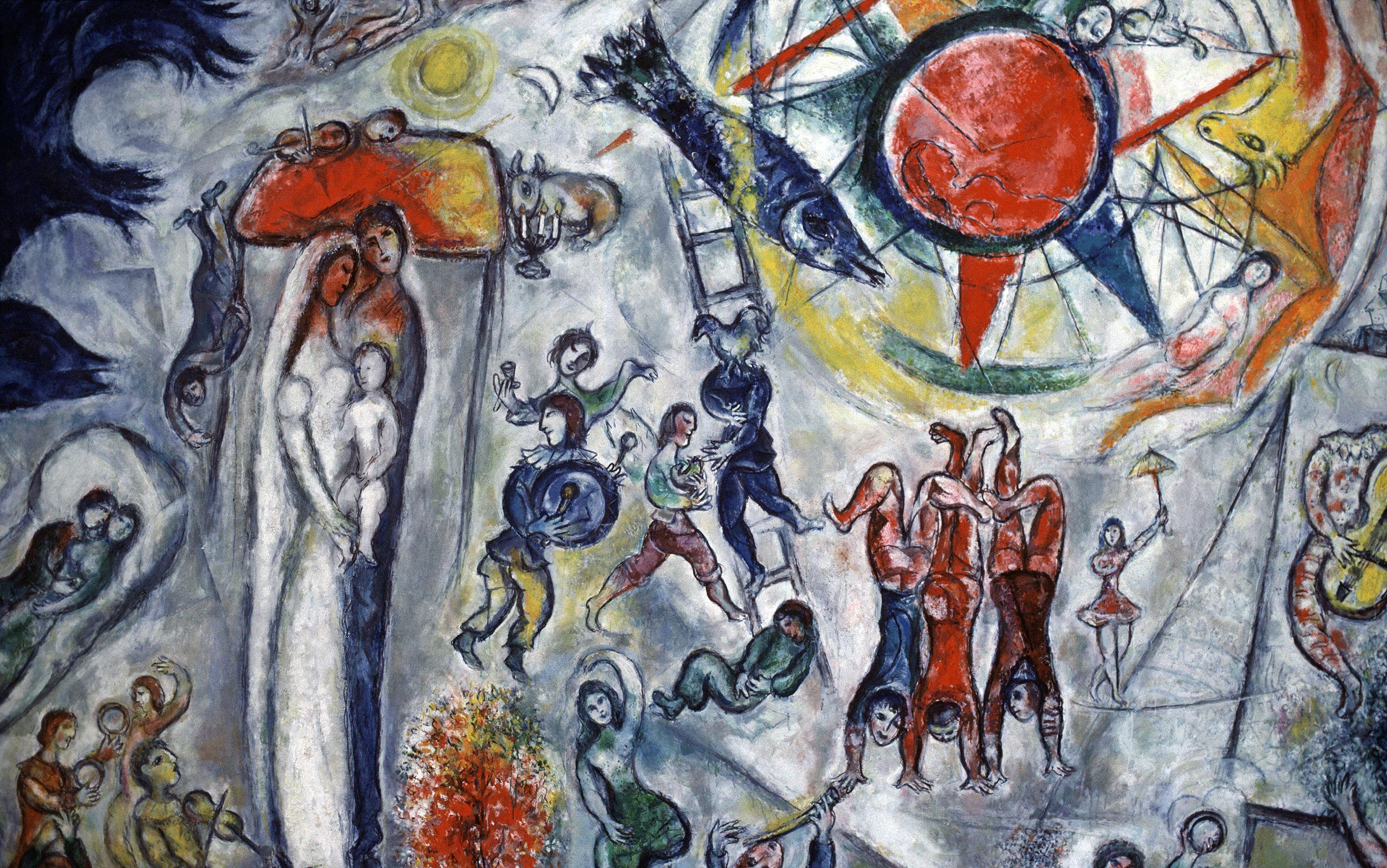Due to a case of partial blindness, the French painter Henri Matisse began experimenting with a new artistic method in the final decades of his life. He called it ‘drawing with scissors’. He would cut out large chucks of gouache-painted paper and arrange the pieces into visually arresting feats of abstraction, often depicting vegetable and animal life.
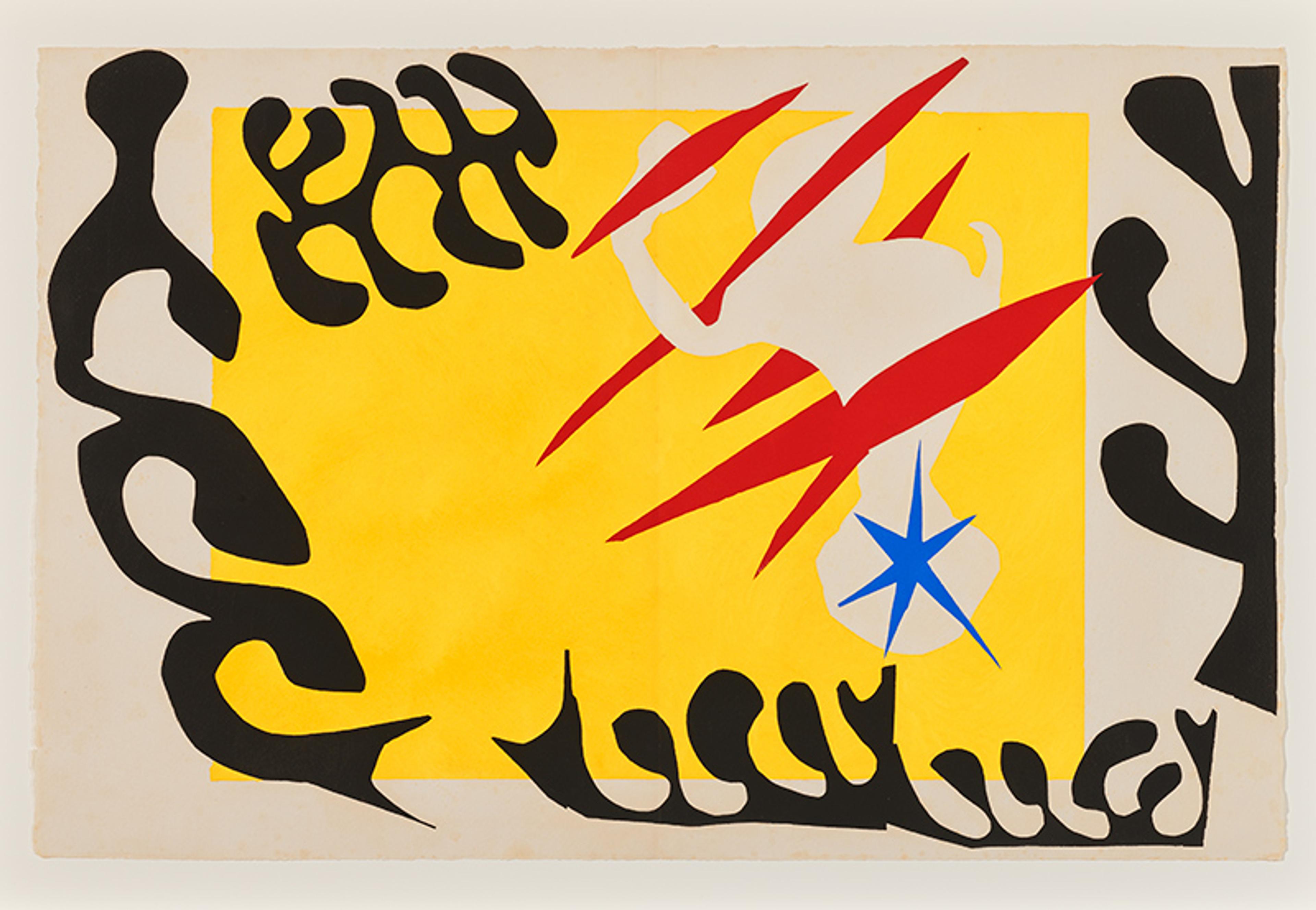
Henri Matisse (France, b.1869, d.1954) The Nightmare of the White Elephant from the illustrated book Jazz 1947. Colour stencil, 42.2 x 65.1 cm. Art Gallery of New South Wales/ Margaret Hannah Olley Art Trust 2014. © Succession H Matisse/Copyright Agency. Image © AGNSW
In one of these cut-outs, Le Cauchemar de l’éléphant blanc (‘The Nightmare of the White Elephant’, 1947), an elephant balances on a circus ball. The animal’s body is traversed by piercing flashes of red, and fenced in on all sides by large and black undulant shapes that resemble some kind of ancestral algae. According to Matisse’s personal assistant, ‘the white elephant is performing its act standing on a ball, under dazzling circus lights, while memories of his native black forest assail him like red tongues of fire, with all the violence of arrows’.
A powerful example of Matisse’s ‘fauvism’ (a style of art named after fauve, meaning ‘wild beast’ in French), this work invites us to consider not only the real-life nightmares that human institutions such as the circus are for the unlucky creatures who end up in them, but also the literal nightmares – and, by extension, dreams – that these creatures experience in these and other places at night, when the body rests but the mind wanders.
Interest in the dreams of animals is nothing new. Nineteenth-century naturalists such as Charles Darwin wrote at length about the dreams of other species from an evolutionary perspective, often to drive home the point that our minds and those of our fellow nonhumans exist on a natural continuum. In The Descent of Man (1871), for instance, Darwin writes:
No one supposes that one of the lower animals reflects whence he comes or whither he goes, – what is death or what is life, and so forth. But can we feel sure that an old dog with an excellent memory and some power of imagination, as shewn [sic] by his dreams, never reflects on his past pleasures in the chase? and this would be a form of self-consciousness.
Other animals may not ponder deep, existential questions, but the fact that they dream proves that they possess formidable memories and complex imaginations, even if their dreams flow in and out of them, as Darwin says, ‘without the aid of any form of language’.
In 1892, two decades after the publication of The Descent of Man, the Spanish philosopher José Miguel Guardia had an article published in the French journal Revue philosophique de la France et de l’étranger in which, following Darwin, he maintained that other earthlings are as intimately acquainted with ‘the metamorphoses of the nocturnal imagination’ as we are. Guardia took these metamorphoses to be such an essential feature of the ebb and flow of animal experience that he believed it was time for philosophers to formulate a radically new philosophy of animality – a non-mechanistic one, to be exact.
As psychic events, dreams are too complex to be reduced to a collection of unselfconscious, visceral automatisms. For this reason, the dreams of animals upend the image of the animal-machine that Europeans inherited from René Descartes in the 17th century. If anything, Guardia says, dreams bear witness to the sensibilité intrinsic to animal life.
The word sensibilité is key here. Usually, this term is translated into English as ‘sensation’, creating the unfortunate impression that the only thing under consideration is an animal’s capacity to react instinctively and mechanically to the external world. In its French context, however, the term captures a larger constellation of meanings, including what Anglophones call ‘sensation’, but also ‘sentience’, ‘sensoriality’, ‘sentiment’, ‘sensibility’ and even ‘sense’. Guardia’s argument puts all these associations into play. Thus, when he says that animals have sensibilité, what he is saying is that they register and process all sorts of internal and external stimuli and have various degrees of self-awareness, including their own modes of perceiving and interpreting the world, as well as a layered emotional life. They are subjects who, through their own activity, penetrate the density of existence, endowing it with purpose, sense and meaning.
Asleep, animals also renounce the real world to give themselves over to a phantasmatic universe
In short, Guardia paints a lively picture of nonhuman experience by appealing solely to the dreams of animals. For him, all dreams are unintelligible from within the confines of a mechanistic philosophy and can be understood only from the perspective of ‘comparative psychology’, which treats the psyches of human and nonhuman life forms as variations on a common biological theme. That theme being, of course, the sensibilité proper to animal life. ‘For each of us knows,’ he says, ‘that the partisans of automatism refuse all sensibilité to the animal-machine.’
Unfortunately, the interest in the dreams of animals displayed by thinkers such as Darwin and Guardia began to wane at the turn of the 20th century. The historian of science Iwan Rhys Morus explains that, during this period, the life sciences felt an extraordinary pressure to emulate the methods of the physical sciences and model themselves after their image. In this new climate, it became virtually impossible for the mental feats of animals, which do not lend themselves easily to physical or mechanical explanations, to hold the same sway over the scientific imagination as before.
This pressure remains with us to this day. Even as scientific attitudes have shifted, it is not hard to find prominent scientists who adamantly believe that science should stay far away from any ‘speculative’ debates about the mental states of other animals, especially their dreams. In their view, these debates are roads to nowhere. As long as we lack direct access to the lived experience of other species, we should follow Ludwig Wittgenstein’s advice: ‘Whereof one cannot speak, thereof one must be silent.’
Yet, new developments in dream and animal sleep research are beginning to push back against this position by suggesting that other animals really do dream; that, upon falling asleep, they also renounce the real world in order to give themselves over to a phantasmatic, unearthly universe of their own creation. These developments deserve our unbroken attention since they raise fundamental questions about who animals are, how their minds operate, and the extent to which they ‘participate in the original artistry of … experience’, as the psychologist Willow Pearson would say.
Our question is epistemological: how can we know whether animals dream? When it comes to humans, we accept two kinds of evidence in connection with this question. There is first-person evidence, which takes the form of verbal reports from the dreamers themselves. And there is third-person evidence, which usually takes the form of enquiry into the neural correlates of dream experiences and interpretation of sleep behaviours that allude to dream phenomenology. Admittedly, as we transition from humans to nonhumans, we lose all first-person evidence since other animals cannot produce dream reports. But this need not mean that we cannot still learn something meaningful and powerful about their dreams, especially if we are willing to sift through the relevant neural and behavioural evidence.
Let’s start with the neural side of the equation. Although dream experts disagree about what the neural signatures of dreaming are and where they are located in the brain, there is widespread agreement that two neural events merit special consideration. One is the so-called PGO waves that trigger dreaming during REM sleep, which is the phase of the human sleep cycle when dream experiences abound. These brain waves are ascending bursts of neural activity that originate in the pons (P), pass through the lateral geniculate nucleus of the thalamus (G), and terminate in the occipital lobe (O).
The other is the theta oscillations (from 4 up to 12 Hz) that regularly crop up whenever consciousness encroaches upon sleep in the guise of a dream.
Fascinatingly, both PGO waves and theta oscillations have been detected in a wide variety of nonhumans. PGO waves have been discovered in animals as evolutionarily close to us as nonhuman primates and as evolutionarily distant from us as zebrafish. Meanwhile, theta oscillations, especially in the hippocampus, have been well documented in a plethora of mammals.
Humans are not the only animals who rehearse virtual scenarios while taking their Zs
‘The theta rhythm disappears in slow wave sleep but reappears in REM sleep,’ explains the dream neuroscientist Antti Revonsuo. At the same time, ‘the hippocampal theta rhythm is associated with behaviours requiring responses to changing environmental information most crucial to survival: for example, predatory behaviour in the cat, and prey behaviour in the rabbit.’ The suggestion is that ‘information important for survival is accessed during REM sleep and integrated with past experience to provide a strategy for future behaviour’.
Revonsuo is the father of the ‘threat simulation theory of dreaming’, which holds that an avalanche of electrochemical changes during sleep sets the stage for our brains to run reality simulations that enable us to practise important survival skills while ‘offline’. This reality-simulating function, he says, must have evolved in an ancestral environment, giving our predecessors an adaptive edge over their competitors. Just how ancestral this environment is remains a lively question, especially if humans are not the only animals who rehearse virtual scenarios while taking their Zs.
The idea that other animals enact virtual realities while asleep is supported by research on mental replay, a neuronal event that occurs when the sleeping brain replays episodes from waking life. Birds, for example, replay their songs while asleep in order to better memorise them. Rats also replay episodes from waking life, except that they tend to replay visual rather than auditory experiences. When they fall asleep, they often immerse themselves in a multifaceted dreamworld whose spatial coordinates seamlessly mirror those of their waking milieu.
Although not all instances of mental replay herald a dream sequence, some do, according to Josie Malinowski, David Scheel and Mitchel McCloskey, whose exciting paper on animal dreaming was published in 2021. This shows that sleep is not a long and monotonous mental slumber for animals, but a fluctuating mental reality punctuated by moments of conscious awareness. Citing the latest research on mental replay, they write:
these lines of evidence may point towards some conscious experiencing during replay, which may be conceptualised as a form of animal dreaming, particularly in reference to the visual and affective characteristics of human dreaming. This may be especially likely in REM sleep, which is very often accompanied by dreaming in humans.
Malinowski, Scheel and McCloskey believe that this ‘conscious experiencing’ extends far beyond mammals to birds and insects. Even honeybees might dream!
Complementing all this neuroscientific evidence is the behavioural side of the equation. For a long time, people from very different cultures have known that the behaviours of sleeping animals (now known as oneiric behaviours) reveal what is happening in their dreams. When an animal displays rapid eye movements (REMs), sleep-vocalising, sleep-running and sleep-fighting, it is likely that said animal is thrusting itself onto a virtual reality in which these behaviours make sense.
Consider the curious case of chimpanzees who talk in their sleep. In the 1990s, the primatologist Kimberly Mukobi discovered that chimpanzees trained in American Sign Language (ASL) make unmistakable ASL signs while asleep. She observed one chimpanzee named Loulis making the sign for ‘good’ in the middle of the night. And Loulis wasn’t the only one. There were other chimpanzees who made other signs, including Washoe who made the ASL sign for ‘coffee’.
Interestingly, sleep-talking is quite common in sleeping humans and frequently correlates with dreaming; moreover, sleep-talking is known to manifest as sleep-signing in deaf humans. Mukobi herself cites research dating all the way back to the 1930s showing that ‘increased finger activity in deaf subjects [is] associated with reports of dreaming’. In light of this research, there is a compelling case to be made that the signs made by sleeping chimpanzees are expressions of an underlying dream experience. These primates sign in their sleeping quarters probably because they are also signing in their dreams.
Octopuses may be ideal for the study of dreaming in other species as they wear their dreams on their sleeve
Octopuses may also have somniloquies of their own, as suggested by the motley chromatic displays they make in their sleep. Whether these displays qualify as somni-loquies, however, depends on whether we accept the theory that they represent acts of communication. Some experts warn against this on the grounds that said displays do not always meet the criteria for communication. In his book Other Minds: The Octopus, the Sea, and the Deep Origins of Consciousness (2016), Peter Godfrey-Smith explains that many occur in solitude, when there isn’t even a possible interlocutor in sight. Can an address without an addressee be considered ‘communicative’? Probably not. But even if we admit that these displays are not communicative in the technical sense of the term, they remain exteriorisations of a felt affect. As Godfrey-Smith himself notes, many displays can be reliably mapped on to specific emotional states, such as anger, fear and frustration. Their appearance during sleep, then, could mean that these creatures are experiencing these emotions in the context of a dream.
Either way, it is clear that we can no longer limit our theories of dreaming to humans or even mammals for the simple reason that octopuses, who are neither, are exceptional candidates for dreaming. In fact, Malinowski, Scheel and McCloskey state that they may be the ideal model for the study of dreaming in other species since they wear their dreams on their sleeve – or, rather, on their mantle. Their chromatic displays allow us to see their dreams from an ethical distance, without invasive and harmful procedures. One can watch a gorgeous example of an octopus dream in the PBS show Octopus: Making Contact (2019).
The philosophical ramifications of animal dreaming are massive, but they are likely to vary depending on our background beliefs about dreaming more generally. For instance, some philosophers believe that dreams are imaginings; others believe that they are beliefs; and still others believe that they are a subspecies of hallucinations. There is no right or wrong answer here, but there are different implications to each position.
If dreams are imaginings, does this mean that animals can generate sensory images that do not correspond to their physical surroundings? Can animals ‘presentify’ what is absent?
By contrast, if dreams are beliefs, does this mean that animals can form beliefs about the world, even when they have been disconnected from it by the neurophysiology of sleep? And, if so, what would this mean for the philosophical view that all beliefs have a propositional structure and thus require the possession of human-style syntax? Could the dreams of other animals refute a widespread philosophical theory of how our own minds work?
They unearth layers of social, cognitive and emotional complexity in other minded life forms
And if dreams are hallucinations, then what? Can animals tell the difference between perception and hallucination? And what impact might this have on the theory that it is impossible even for humans to discriminate, from the inside, between a hallucination and a veridical perception?
These positions by no means exhaust the philosophical literature on dreams. Other theories about the nature and function of dreaming that could have unforeseen implications for our understanding of animal consciousness include: (1) the theory that dreams are impossible without a rich emotional life; (2) the theory that dreams entail top-down mental causation; (3) the theory that dreams can help us solve real-world problems; (4) the theory that dreams aid in the healing of trauma; (5) the theory that dreams forge our narrative sense of self; (6) the theory that dreams are acts of metacognition; (7) the theory that dreams are forms of wish-fulfilment; and (8) the theory that dreams are elaborations of the unconscious.
I am not saying we need to embrace any one of these positions (although I have my favourites). But I am saying that, paradoxically, they all yield the same result: they unearth hitherto unknown layers of social, cognitive and emotional complexity in other minded life forms; they reveal colours, harmonies and beauties in the psychic lives of other dreamers, of which perhaps we had little inkling until now.
As exciting as it may be, a journey into the dreamworlds of animals requires caution. First and foremost, we must respect the diversity of nature and not assume that all creatures who dream dream like we do. In all likelihood, different animals construct their dreamworlds in the same way they construct their waking realities – ie, in line with the sensory, perceptual, affective and cognitive capacities characteristic of their species, as well as the peculiarities of their own developmental trajectories and life histories.
For example, most human dreams are heavy in visual content, but the dreams of other animals need not be similarly visual, or visual at all. And they need not produce the same behaviours either. The majority of humans consistently display rapid eye movements during REM sleep, but rats make rapid whisker movements, probably because touch is more important than vision to their experience of the world. Horses make rapid nasal-labial movements, which leads me to suspect that auditory vocalisations may be particularly important in theirs. What other bodily movements might betray the nightly secrets of other, less familiar species? What behaviours shall we look for in the sleeping orca, ostrich or okapi, or in the eagle, eft or eel? All I know is: we have no choice but to keep an open mind.
Margaret Atwood captured this diversity beautifully in her poem ‘Dreams of the Animals’ (1970), whose opening lines go as follows:
Mostly the animals dream
of other animals each
according to its kind
(though certain mice and small rodents
have nightmares of a huge pink
shape with five claws descending)
: moles dream of darkness and delicate
mole smells
frogs dream of green and golden
frogs
sparkling like wet suns
among the lilies
red and black
striped fish, their eyes open
have red and black striped
dreams defense, attack, meaningful
patterns
birds dream of territories
enclosed by singing.
…
That each animal dreams ‘according to its kind’ means that the dreams of an animal can never be divorced from that creature’s evolutionary inheritance, that long list of advantages and liabilities, freedoms and burdens, pluses and minuses that the living receive from the dead as their inalienable birthright.
Perhaps all foxes dream ‘foxy’ dreams, but each fox will dream their ‘foxy’ dream
At the same time, we must not let the magnitude of this inheritance overwhelm our perspective. Animals do not come into the world with a finalised set of species-specific dreams ready to go. It is not as if all members of a species are destined to dream the same dream (or set of dreams) over and over again until their last breath. In the remaining part of her poem, Atwood addresses this issue, pointing out that even if every animal dreams according to its kind, experience injects endless difference into each kind. She writes:
There are exceptions:
the silver fox in the roadside zoo
dreams of digging out
and of baby foxes, their necks bitten
the caged armadillo
near the train
station, which runs
all day in figure eights
its piglet feet pattering,
no longer dreams
but is insane when waking;
the iguana
in the petshop window on St. Catherine
Street
crested, royal-eyed, ruling
its kingdom of water-dish and sawdust
dreams of sawdust
Here, a developmental perspective crisscrosses the evolutionary one articulated in the first half of the poem, begetting a new sense of dreams as Möbius strips in which two temporalities merge into one another ad infinitum: the phylogenetic time of the species and the ontogenetic time of individual. Every dream reflects the dreamer’s identity as a member of a species, as well as their unique curiosities, desires and trepidations as an individual. Perhaps all foxes dream ‘foxy’ dreams, but each fox will dream their ‘foxy’ dream – a dream that, in its very architecture, reflects and projects the individuality of its maker.
Whether we are academics, activists or lay people, we should strive for an Atwoodian sensibility to animals, a way of seeing animal experience as unfolding in the fault line between the universalism of the species and the particularism of the individual, in the gap between evolution and experience. It is only by attending to this line that we can hope to illuminate what Guardia dubs ‘organic consciousness’, which is the consciousness animating all animal life, from the bark beetle to the blue whale.
